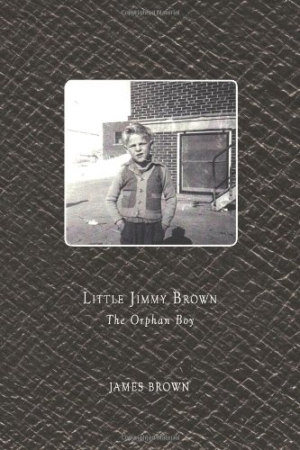
Little Jimmy Brown
The Orphan Boy
In Little Jimmy Brown, James Brown shares the highs and lows of growing up in an orphanage in the 1940s.
At the beginning of the book, Brown’s birth mother, Georgia, tells her own story. She falls in love with a sailor (her sisters keep him from finding out about Georgia’s pregnancy), moves home to Nebraska to raise her son on her own, and eventually succumbs to Huntington’s disease as Jimmy becomes a toddler. This part of the book gives readers all of the information they need to understand Brown’s background. It’s in this section that readers meet Georgia’s father, Brown’s grandfather, who continues as a valuable part of the author’s family even during the orphanage years.
From there, Brown’s quaint but clear voice tells readers about his transition to life in an orphanage. (His mother is too ill to care for him, his grandfather is too old, and the other family members are unable or cannot afford to take him in.) He covers the practicalities of day-to-day life, including the dormitory matrons and the chapel and bell system. It’s in this section that Brown shows through his own life why he believes that orphanage life is better than foster care. While some readers may be skeptical of this thought, Brown thoroughly touts the benefits of the stability and structure of growing up in an orphanage.
Readers also meet Jimmy’s friend Bobby; they become blood brothers at age eight by the slicing of their thumbs. A series of chance encounters as an adult, including a reunion with Bobby, spawned Brown’s idea to write a memoir.
Brown tackles traumatic moments—saying goodbye to his mother, being left by his grandfather at the orphanage, the fears that kids face in an orphanage, and failed adoption opportunities—in a heart-wrenching way that avoids melodrama. His book contains just the right number of endearing childhood photos.
On occasion, Brown intersperses other people’s stories, including several dormitory matrons, adding nice flavor and color to his own story. He also interrupts the overarching narrative to share anecdotes (“Jimmy Brown Stories”) and tips (“Jimmy Brown Tips”). The anecdotes add depth to the narrative, and the tips deepen the reader’s attachment to Jimmy and show what he’s learned along the way. On the other hand, separating these stories and tips from the main text with headings disrupts the flow of the book.
What happens to Jimmy after the orphanage closes and sends many of its kids into foster care is unclear. Initially, Jimmy moves in with his elderly grandfather, but it seems likely that this situation isn’t a long-term solution. The cliffhanger feels like a tease, as Brown promises to share the rest of his story in his next book. Little Jimmy Brown’s unresolved ending may leave the reader with a bad taste in their mouth after completing this otherwise compelling, poignant narrative about life in an orphanage.
Reviewed by
Melissa Wuske
Disclosure: This article is not an endorsement, but a review. The publisher of this book provided free copies of the book and paid a small fee to have their book reviewed by a professional reviewer. Foreword Reviews and Clarion Reviews make no guarantee that the publisher will receive a positive review. Foreword Magazine, Inc. is disclosing this in accordance with the Federal Trade Commission’s 16 CFR, Part 255.
